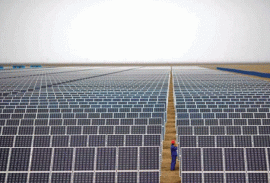
Pakistan’s energy landscape is undergoing a dramatic transformation as the country becomes the third-largest importer of Chinese solar panels, fueled by soaring electricity prices and a growing shift toward renewable energy, according to a World Economic Forum report.
In a remarkable development, Pakistan’s push toward solar adoption is rapidly accelerating, driven largely by market dynamics and external pressures, with minimal political backing.
As a result, Pakistan now ranks as the world’s sixth-largest solar market, and is the third-largest buyer of Chinese-made solar panels, with imports surging to 13 gigawatts (GW) in the first half of 2024. The total expected imports for the year could reach 22GW, marking a significant leap forward in the country’s transition to solar power.
The country’s growing reliance on solar energy has been largely influenced by the dramatic rise in electricity tariffs, which have increased by 155% over the past three years. With grid electricity costs spiraling, many consumers, industries, and businesses have turned to solar power as a more cost-effective and reliable solution. This shift is reshaping the energy landscape and offering a glimpse into the future of energy use in emerging markets.
The surge in solar adoption has been significantly aided by China’s overproduction of solar panels, which has driven down costs, making solar power more accessible to countries like Pakistan. Solar power now serves as an attractive alternative to the country’s strained national grid, which has long struggled with reliability issues and inefficiencies.
In response to the growing demand for solar power, Pakistan has seen industrial, agricultural, and residential sectors embrace solar energy in a big way. The first half of 2024 alone saw the import of 13GW of solar panels from China, with estimates suggesting total imports could reach 22GW by year-end. This marks a major milestone in Pakistan’s energy transition, positioning the country as one of the fastest-growing solar markets globally.
The shift to solar energy has been largely market-driven, with little direct political intervention. While the Pakistani government has shown limited support for the transition, factors such as the rising cost of grid electricity and the overproduction of solar panels in China have played a key role in accelerating the shift toward solarization.
One of the driving forces behind the solar boom is the country’s mounting electricity costs. With grid electricity prices having risen by more than 150% in just three years, many businesses and consumers have sought to reduce their reliance on the national grid by installing solar power systems. In addition to the financial incentives, the declining cost of solar panels, primarily driven by China’s production surplus, has made solar power more affordable and accessible.
The rapid rise in solar adoption, however, comes with challenges. As more consumers and businesses disconnect from the national grid, the demand for grid electricity declines, pushing up the fixed costs that those who remain connected must bear. These rising capacity payments are straining Pakistan's already fragile financial system, contributing to further instability in the energy sector.
Pakistan’s power grid, which has long been plagued by inefficiencies and underinvestment, is struggling to cope with the growing integration of solar power. The country’s national grid, unable to provide consistent and reliable electricity, is facing the risk of further deterioration as more and more consumers abandon it in favor of self-generation via solar panels.
The need for grid modernization has become more urgent as solar power adoption accelerates. The integration of distributed renewable energy sources like solar is creating new challenges for Pakistan’s electricity infrastructure, and experts warn that without significant upgrades, the national grid could face a downward debt spiral, exacerbated by the rising costs of capacity payments.
In addition to these challenges, the country’s inconsistent energy policy, which has been marred by inefficiencies in electricity production, pricing, and regulation, is further deepening the energy crisis. Recent electricity price hikes, which some see as an alternative tax on consumers, have led to a sharp decline in grid electricity consumption, prompting more industries and businesses to turn to solar energy.
Despite these difficulties, Pakistan’s energy transition offers significant lessons for other emerging economies. The country’s experience demonstrates the importance of reducing reliance on traditional energy sources while balancing the need for grid stability and economic sustainability. With China playing a central role in Pakistan’s solar energy shift, both as a key supplier of solar panels and an investor in the country’s energy projects, the global nature of this transition is clear.
The momentum toward solar energy adoption in Pakistan has been further accelerated by falling battery costs, which are enabling more consumers to adopt solar-plus-storage solutions. This trend is expected to continue, with solar power expected to play an increasingly vital role in the country’s energy mix.
However, experts warn that the rapid transition to solar energy, if not managed effectively, could have unintended consequences for the national grid. The growing reliance on distributed solar power systems is raising questions about the long-term viability of traditional state-run grids, which have been unable to meet the country’s rising demand for energy.
Pakistan’s experience highlights the urgent need for grid modernization, investment in smart energy infrastructure, and comprehensive market reforms to ensure the smooth integration of renewable energy sources. Additionally, as the global demand for clean energy continues to rise, emerging economies like Pakistan will need to rethink their energy strategies to avoid falling behind in the global race to decarbonize.

1736541297-0/Untitled-design-(59)1736541297-0-165x106.webp)






1717094574-6/Buddhist-leaders-Taxila-Museum-(2)1717094574-6-270x192.webp)














COMMENTS
Comments are moderated and generally will be posted if they are on-topic and not abusive.
For more information, please see our Comments FAQ